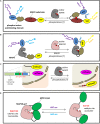Cellular Complexity in MAPK Signaling in Plants: Questions and Emerging Tools to Answer Them
- PMID: 30538711
- PMCID: PMC6277691
- DOI: 10.3389/fpls.2018.01674
Cellular Complexity in MAPK Signaling in Plants: Questions and Emerging Tools to Answer Them
Abstract
Mitogen activated protein kinase (MAPK) cascades play an important role in many aspects of plant growth, development, and environmental response. Because of their central role in many important processes, MAPKs have been extensively studied using biochemical and genetic approaches. This work has allowed for the identification of the MAPK genes and proteins involved in a number of different signaling pathways. Less well developed, however, is our understanding of how MAPK cascades and their corresponding signaling pathways are organized at subcellular levels. In this review, we will provide an overview of plant MAPK signaling, including a discussion of what is known about cellular mechanisms for achieving signaling specificity. Then we will explore what is currently known about the subcellular localization of MAPK proteins in resting conditions and after pathway activation. Finally, we will discuss a number of new experimental methods that have not been widely deployed in plants that have the potential to provide a deeper understanding of the spatial and temporal dynamics of MAPK signaling.
Keywords: MAPK; activity sensors; microscopy; phosphorylation; plant; signaling cascade.
Figures

References
-
- Ahlfors R., Macioszek V., Rudd J., Brosché M., Schlichting R., Scheel D., et al. (2004). Stress hormone-independent activation and nuclear translocation of mitogen-activated protein kinases in Arabidopsis thaliana during ozone exposure. Plant J. 40 512–522. 10.1111/j.1365-313X.2004.02229.x - DOI - PubMed
-
- Bartels S., Anderson J. C., Gonzalez Besteiro M. A., Carreri A., Hirt H., Buchala A., et al. (2009). MAP kinase phosphatase1 and protein tyrosine phosphatase1 are repressors of salicylic acid synthesis and snc1-mediated responses in Arabidopsis. Plant Cell 21 2884–2897. 10.1105/tpc.109.067678 - DOI - PMC - PubMed
Publication types
LinkOut - more resources
Full Text Sources

